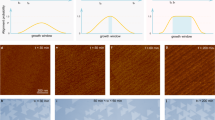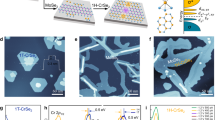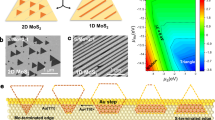Abstract
Mirror twin boundary (MTB) brings unique one-dimensional (1D) physics and properties into two-dimensional (2D) transition metal dichalcogenides (TMDCs), but they were rarely observed in non-Mo-based TMDCs. Herein, by post-growth Nb doping, high density 4|4E-W and 4|4P-Se mirror twin boundaries (MTBs) were introduced into molecular beam epitaxy (MBE) grown WSe2 monolayers. Of them, 4|4E-W MTB with a novel structure was discovered experimentally for the first time, while 4|4P-Se MTBs present a random permutations of W and Nb, forming a 1D alloy system. Comparison between the doped and non-doped WSe2 confirmed that Nb dopants are essential for MTB formation. Furthermore, quantitative statistics reveal the areal density of MTBs is directly proportional to the concentration of Nb dopants. To unravel the injection pathway of Nb dopants, first-principles calculations about a set of formation energies for excess Nb atoms with different configurations were conducted, based on which a model explaining the origin of MTBs introduced by excess metal was built. We conclude that the formation of MTBs is mainly driven by the collective evolution of excess Nb atoms introduced into the lattice of host WSe2 crystal and subsequent displacement of metal atoms (W or Nb). This study provides a novel way to tailor the MTBs in 2D TMDC materials via proper metal doping and presents new opportunities for exploring the intriguing properties.

Similar content being viewed by others
References
Novoselov, K. S.; Neto, A. H. C. Two-dimensional crystals-based heterostructures: Materials with tailored properties. Phys. Scr.2012, 2012, 014006.
Wang, Q. H.; Kalantar-Zadeh, K.; Kis, A.; Coleman, J. N.; Strano, M. S. Electronics and optoelectronics of two-dimensional transition metal dichalcogenides. Nat. Nanotechnol.2012, 7, 699–712.
Xiao, D.; Liu, G. B.; Feng, W. X.; Xu, X. D.; Yao, W. Coupled spin and valley physics in monolayers of MoS2 and other group-VI dichalcogenides. Phys. Rev. Lett.2012, 108, 196802.
Gao, G. P.; O’Mullane, A. P.; Du, A. J. 2D MXenes: A new family of promising catalysts for the hydrogen evolution reaction. ACS Catal.2017, 7, 494–500.
Zhang, Q.; Ren, Z. M.; Wu, N.; Wang, W. J.; Gao, Y. J.; Zhang, Q. Q.; Shi, J.; Zhuang, L.; Sun, X. N.; Fu, L. Nitrogen-doping induces tunable magnetism in ReS2. npj 2D Mater. Appl.2018, 2, 22.
Andriotis, A. N.; Menon, M. Tunable magnetic properties of transition metal doped MoS2. Phys. Rev. B2014, 90, 125304.
Coelho, P. M.; Komsa, H. P.; Lasek, K.; Kalappattil, V.; Karthikeyan, J.; Phan, M. H.; Krasheninnikov, A. V.; Batzill, M. Room-temperature ferromagnetism in MoTe2 by post-growth incorporation of vanadium impurities. Adv. Electron. Mater.2019, 5, 1900044.
Yu, Y. J.; Yang, F. Y.; Lu, X. F.; Yan, Y. J.; Cho, Y. H.; Ma, L. G.; Niu, X. H.; Kim, S.; Son, Y. W.; Feng, D. L. et al. Gate-tunable phase transitions in thin flakes of 1T-TaS2. Nat. Nanotechnol.2015, 10, 270–276.
Gong, Y. J.; Liu, Z.; Lupini, A. R.; Shi, G.; Lin, J. H.; Najmaei, S.; Lin, Z.; Elías, A. L.; Berkdemir, A.; You, G. et al. Band gap engineering and layer-by-layer mapping of selenium-doped molybdenum disulfide. Nano Lett.2014, 14, 442–449.
Xia, Y. P.; Wang, B.; Zhang, J. Q.; Feng, Y.; Li, B.; Ren, X. B.; Tian, H.; Xu, J. P.; Ho, W.; Xu, H. et al. Hole doping in epitaxial MoSe2 monolayer by nitrogen plasma treatment. 2D Mater.2018, 5, 041005.
Xia, Y. P.; Zhang, J. Q.; Yu, Z. B.; Jin, Y. J.; Tian, H.; Feng, Y.; Li, B.; Ho, W.; Liu, C.; Xu, H. et al. A shallow acceptor of phosphorous doped in MoSe2 monolayer. Adv. Electron. Mater., in press, DOI: 10.1002/aelm.201900830.
Hong, J. H.; Wang, C.; Liu, H. J.; Ren, X. B.; Chen, J. L.; Wang, G. Y.; Jia, J. F.; Xie, M. H.; Jin, C. H.; Ji, W. et al. Inversion domain boundary induced stacking and bandstructure diversity in bilayer MoSe2. Nano Lett.2017, 17, 6653–6660.
McDonnell, S.; Addou, R.; Buie, C.; Wallace, R. M.; Hinkle, C. L. Defect-dominated doping and contact resistance in MoS2. ACS Nano2014, 8, 2880–2888.
Jolie, W.; Murray, C.; Weiß, P. S.; Hall, J.; Portner, F.; Atodiresei, N.; Krasheninnikov, A. V.; Busse, C.; Komsa, H. P.; Rosch, A. et al. Tomonaga-Luttinger liquid in a box: Electrons confined within MoS2 mirror-twin boundaries. Phys. Rev. X2019, 9, 011055.
Xia, Y. P.; Zhang, J. Q.; Jin, Y. J.; Ho, W.; Xu, H.; Xie, M. H. Quantum confined Tomonaga-Luttinger liquid in MoSe2 twin domain boundaries. arXiv:1908.09259 2019.
Ma, Y. J.; Diaz, H. C.; Avila, J.; Chen, C. Y.; Kalappattil, V.; Das, R.; Phan, M. H.; Čadež, T.; Carmelo, J. M. P.; Asensio, M. C. et al. Angle resolved photoemission spectroscopy reveals spin charge separation in metallic MoSe2 grain boundary. Nat. Commun.2017, 8, 14231.
Barja, S.; Wickenburg, S.; Liu, Z. F.; Zhang, Y.; Ryu, H.; Ugeda, M. M.; Hussain, Z.; Shen, Z. X.; Mo, S. K.; Wong, E. et al. Charge density wave order in 1D mirror twin boundaries of single-layer MoSe2. Nat. Phys.2016, 12, 751–756.
Batzill, M. Mirror twin grain boundaries in molybdenum dichalco-genides. J. Phys.: Condens. Matter2018, 30, 493001.
Coelho, P. M.; Komsa, H. P.; Coy Diaz, H.; Ma, Y. J.; Krasheninnikov, A. V.; Batzill, M. Post-synthesis modifications of two-dimensional MoSe2 or MoTe2 by incorporation of excess metal atoms into the crystal structure. ACS Nano2018, 12, 3975–3984.
Jiao, L.; Liu, H. J.; Chen, J. L.; Yi, Y.; Chen, W. G.; Cai, Y.; Wang, J. N.; Dai, X. Q.; Wang, N.; Ho, W. K. et al. Molecular-beam epitaxy of monolayer MoSe2: Growth characteristics and domain boundary formation. New J. Phys.2015, 17, 053023.
Ma, Y. J.; Kolekar, S.; Coy Diaz, H.; Aprojanz, J.; Miccoli, I.; Tegenkamp, C.; Batzill, M. Metallic twin grain boundaries embedded in MoSe2 monolayers grown by molecular beam epitaxy. ACS Nano2017, 11, 5130–5139.
Diaz, H. C.; Ma, Y. J.; Chaghi, R.; Batzill, M. High density of (pseudo) periodic twin-grain boundaries in molecular beam epitaxy-grown van der Waals heterostructure: MoTe2/MoS2. Appl. Phys. Lett.2016, 108, 191606.
Liu, H. J.; Jiao, L.; Xie, L.; Yang, F.; Chen, J. L.; Ho, W. K.; Gao, C. L.; Jia, J. F.; Cui, X. D.; Xie, M. H. Molecular-beam epitaxy of monolayer and bilayer WSe2: A scanning tunneling microscopy/ spectroscopy study and deduction of exciton binding energy. 2D Mater.2015, 2, 034004.
Jones, A. M.; Yu, H. Y.; Ghimire, N. J.; Wu, S. F.; Aivazian, G.; Ross, J. S.; Zhao, B.; Yan, J. Q.; Mandrus, D. G.; Xiao, D. et al. Optical generation of excitonic valley coherence in monolayer WSe2. Nat. Nanotechnol.2013, 8, 634–638.
Aivazian, G.; Gong, Z. R.; Jones, A. M.; Chu, R. L.; Yan, J.; Mandrus, D. G.; Zhang, C. W.; Cobden, D.; Yao, W.; Xu, X. Magnetic control of valley pseudospin in monolayer WSe2. Nat. Phys.2015, 11, 148–152.
Srivastava, A.; Sidler, M.; Allain, A. V.; Lembke, D. S.; Kis, A.; Imamoglu, A. Valley Zeeman effect in elementary optical excitations of monolayer WSe2. Nat. Phys.2015, 11, 141–147.
Komsa, H. P.; Krasheninnikov, A. V. Engineering the electronic properties of two-dimensional transition metal dichalcogenides by introducing mirror twin boundaries. Adv. Electron. Mater.2017, 3, 1600468.
Lin, Y. C.; Björkman, T.; Komsa, H. P.; Teng, P. Y.; Yeh, C. H.; Huang, F. S.; Lin, K. H.; Jadczak, J.; Huang, Y. S.; Chiu, P. W. et al. Three-fold rotational defects in two-dimensional transition metal dichalcogenides. Nat. Commun.2015, 6, 6736.
Pennycook, S. J.; Nellist, P. D. Scanning Transmission Electron Microscopy: Imaging and Analysis; Springer: New York, 2011.
Komsa, H. P.; Krasheninnikov, A. V. Two-dimensional transition metal dichalcogenide alloys: Stability and electronic properties. J. Phys. Chem. Lett.2012, 3, 3652–3656.
Schneemeyer, L. F.; Sienko, M. J. Crystal data for mixed-anion molybdenum dichalcogenides. Inorg. Chem.1980, 19, 789–791.
Liu, H. J.; Jiao, L.; Yang, F.; Cai, Y.; Wu, X. X.; Ho, W.; Gao, C. L.; Jia, J. F.; Wang, N.; Fan, H. et al. Dense network of one-dimensional midgap metallic modes in monolayer MoSe2 and their spatial undulations. Phys. Rev. Lett.2014, 113, 066105.
Karthikeyan, J.; Komsa, H. P.; Batzill, M.; Krasheninnikov, A. V. Which transition metal atoms can be embedded into two-dimensional molybdenum dichalcogenides and add magnetism? Nano Lett.2019, 19, 4581–4587.
Han, D.; Ming, W. M.; Xu, H. X.; Chen, S. Y.; Sun, D. Y.; Du, M. H. Chemical trend of transition-metal doping in WSe2. Phys. Rev. Appl.2019, 12, 034038.
Lin, J. H.; Pantelides, S. T.; Zhou, W. Vacancy-induced formation and growth of inversion domains in transition-metal dichalcogenide monolayer. ACS Nano2015, 9, 5189–5197.
Gupta, S.; Yang, J. H.; Yakobson, B. I. Two-level quantum systems in two-dimensional materials for single photon emission. Nano Lett.2019, 19, 408–414.
Voiry, D.; Yang, J.; Chhowalla, M. Recent strategies for improving the catalytic activity of 2D TMD nanosheets toward the hydrogen evolution reaction. Adv. Mater.2016, 28, 6197–6206.
Kresse, G.; Furthmüller, J. Efficiency of ab-initio total energy calculations for metals and semiconductors using a plane-wave basis set. Comput. Mater. Sci.1996, 6, 15–50.
Kresse, G.; Joubert, D. From ultrasoft pseudopotentials to the projector augmented-wave method. Phys. Rev. B1999, 59, 1758–1775.
Perdew, J. P.; Burke, K.; Ernzerhof, M. Generalized gradient approximation made simple. Phys. Rev. Lett.1996, 77, 3865–3868.
Acknowledgements
The authors thank Zhoubin Yu for fruitful discussions, Dr. Fang Lin for kindly providing the codes for two-Gaussians filtering, Degong Ding, Haifeng Wang, and Daliang He for critical comments on editing the manuscript. B.W. and C.J. acknowledged financial support from the National Natural Science Foundation of China (Nos. 51761165024, 51772265, and 61721005), the Zhejiang Provincial Natural Science Foundation (No. D19E020002), the 111 project (No. B16042) and Zhejiang University Education Foundation Global Partnership Fund. M. H. X. acknowledges the financial support from a Collaborative Research Fund (C7036-17W) and a General Research Grant (No. 17327316) from the Research Grant Cuncil, Hong Kong special Administrative Region, China. We also acknowledge the support from the NSFC/RGC joint research grant (Nos. N_HKU732/17 and 51761165024). H. P. K. acknowledges financial support from the Academy of Finland through Project No. 311058, and CSC-IT Center for Science Ltd. for generous grants of computer time. The work on electron microscopy was carried out at the Center of Electron Microscopy of Zhejiang University.
Author information
Authors and Affiliations
Corresponding authors
Electronic Supplementary Material
Rights and permissions
About this article
Cite this article
Wang, B., Xia, Y., Zhang, J. et al. Niobium doping induced mirror twin boundaries in MBE grown WSe2 monolayers. Nano Res. 13, 1889–1896 (2020). https://doi.org/10.1007/s12274-020-2639-6
Received:
Revised:
Accepted:
Published:
Issue Date:
DOI: https://doi.org/10.1007/s12274-020-2639-6




